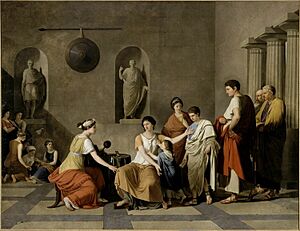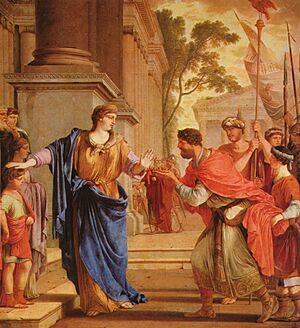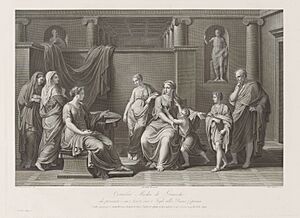Cornelia (mother of the Gracchi) facts for kids
Cornelia (around 190s – 115 BC) was an important Roman woman known for her intelligence and strong character. She was the second daughter of Publius Cornelius Scipio Africanus, a famous Roman general from the Second Punic War. Cornelia was different from many Roman women of her time because she loved reading and writing. She also played a big role in the political careers of her sons. She was the mother of the famous Gracchi brothers, Tiberius and Gaius Gracchus.
Contents
Her Life Story
Cornelia married Tiberius Sempronius Gracchus when he was older. They had a happy marriage and an unusually large family of 12 children! Sadly, only three of them lived to be adults: Sempronia, who married her cousin Publius Cornelius Scipio Aemilianus, and her two sons, the Gracchi brothers. These brothers later tried to make big changes to Roman laws, which caused a lot of debate.
After her husband passed away, Cornelia chose not to marry again. She focused on raising and educating her children. She even turned down a marriage proposal from King Ptolemy VIII Physcon of Egypt. This showed her dedication to her family and her desire to raise her children her own way.
Later in her life, Cornelia deeply studied literature, Latin, and Greek. She even brought Greek scholars, like the philosophers Blossius and Diophanes, to Rome to help educate her sons. She believed strongly in the power of education. Her efforts helped her sons become skilled Roman leaders. Cornelia was very proud of Tiberius and Gaius. She supported them even when their ideas upset the powerful patrician families, which was her own family background. According to the writer Valerius Maximus, she famously compared her children to her "jewels."
After her sons died, Cornelia moved away from Rome to a large house in Misenum. She continued to welcome many learned people, including Greek scholars, who came to discuss their ideas. The people of Rome admired her virtues. When she died at an old age, they honored her with a statue in the city.
Her Role in Politics

In ancient Rome, women usually did not take part directly in politics. So, it's hard to know exactly how much Cornelia was involved in her sons' political lives. However, there is evidence that she was very engaged and supportive.
One common practice in Rome was to strengthen a family's political power through marriages. Cornelia's daughter, Sempronia, married her cousin. This marriage helped continue the important Scipio family name. It also boosted her husband's political standing.
Cornelia's relationship with her adult sons was very important. Much of what we know comes from the writer Plutarch. He wrote about her in his books, Life of Tiberius Gracchus and Life of Gaius Gracchus. Plutarch shows Cornelia as being active during her sons' political careers, especially during Gaius'.
For example, Plutarch wrote that Gaius removed a law that had disgraced Marcus Octavius. Octavius was a tribune whom Tiberius had removed from office. Gaius did this because Cornelia asked him to. Plutarch said that the Roman people approved of this because they respected Cornelia so much. Plutarch also suggested that Cornelia might have helped Gaius by hiring foreign workers to support his cause against the powerful consul Lucius Opimius.
Plutarch also tells a story where one of Gaius's political rivals insulted Cornelia. Gaius quickly defended his mother, saying, "How can you compare yourself with Cornelia? Have you given birth to such children as she did?" This shows that the Gracchi brothers used their mother's good reputation to help their political arguments.
Cornelia's Letters

Some old writings by Cornelius Nepos, an early Roman biographer, include parts of a letter supposedly written by Cornelia to her younger son, Gaius. If these letters are real, Cornelia would be one of only a few Roman women whose writings still exist today. They would also show how much influence Roman women had within powerful political families.
The letters might have been written just before Gaius became a tribune in 122 BC. Gaius died the next year in 121 BC. The letters use strong, emotional language, which might have been unusual for a woman writing to an important man at that time.
In one part of the letter, Cornelia expresses her deep concern for Rome. She tells Gaius that taking revenge on enemies is good, but not if it harms their country. She writes that she would rather their enemies stay as they are than for Rome to be destroyed.
In another part, she tells Gaius how much distress he has caused her. She reminds him that she hoped he would take care of her in her old age. She asks him not to do anything important against her wishes, especially since she has little time left. She pleads with him to stop causing trouble for their family and for Rome. She even says, "When I have died, you will sacrifice to me as a parent... At that time does it not shame you to seek prayers of those gods, whom you considered abandoned and deserted when they were alive and on hand?" She prays that he will not continue on this path.
In the 40s BC, Cicero, another famous Roman writer, mentioned Cornelia's letters. He suggested that the Gracchi brothers' speaking style was greatly influenced by their mother's way of speaking. Later, Marcus Fabius Quintilian also said that Cornelia's "extremely learned speech" had been passed down in her letters.
While it's clear that important Romans knew about Cornelia's writings, historians today are not sure if the surviving parts are truly her original words. Some believe they might have been propaganda created by political groups who opposed her sons' reforms. These groups might have wanted to make it seem like Cornelia, a respected woman, was against her sons' ideas. This would make Gaius look like a reckless leader who didn't care about Rome or his mother's wishes. So, the surviving letters could be fakes or changed versions of what Cornelia actually wrote.
The Cornelia Statue
After Cornelia died, a marble statue was built in her honor. Only the base of this statue still exists today. It was the first statue of a non-religious Roman woman put up by her own people in a public place. This statue remained standing even during later political changes. Cornelia became a role model for Roman women for centuries. Later, some conservative politicians changed the statue's inscription. They removed the part that mentioned her sons and instead highlighted her as the daughter of Scipio Africanus.
Her Changing Image Over Time
The real Cornelia is a bit of a mystery. The way she is shown in Roman writings probably tells us more about what she meant to those writers than about her actual life. Her image changed as Roman society evolved, especially the role of women. It's hard to understand her fully because only one work supposedly written by her survives, and its authenticity is debated.
The Cornelia Fragments (the letter parts mentioned above) are believed to be from a letter she wrote to her son Gaius in 124 BC. In this letter, she strongly opposes his plans to become a tribune. She also urges him not to follow the revolutionary policies of his older brother Tiberius, which led to Tiberius's death.
There's a lot of debate about whether these fragments are real. Some experts say the writing style matches that of an educated Roman aristocrat from that time. However, others argue that Cornelia's strong disapproval of Gaius's policies in the letter seems to go against what is known about her strong maternal devotion. Because of these doubts, some scholars think the fragments might be a later fake. They might have been created by someone who wanted to separate Cornelia's political views from her sons'. Others think they could be a "rhetorical exercise," where a writer tried to imagine what Cornelia might have said.
Most experts, however, believe the Fragments are authentic. They think it was a private letter written by a highly educated woman who never intended her stern words to be read by anyone else.
Since the Fragments are the only direct source from Cornelia, our understanding of her mostly comes from how later Roman writers saw her. This is tricky because their descriptions of Cornelia clearly changed over time. Early accounts, especially from Plutarch, show her as a wealthy, educated woman who used her strong speaking skills. These accounts focused more on her education and abilities than on her role as a mother.
Over the centuries, Cornelia's image changed. Roman writers adapted her memory to fit their own ideas. Her education and skills became less important. Instead, she became an example of "idealized maternity." Her education was seen as something she used to teach her sons. She was removed from the political arguments surrounding her family and turned into a heroic figure. As historian Emily Hemelrijk says, "the Cornelia we know is to a high degree a creation of later times."
Modern Representations

A famous story told by Valerius Maximus shows Cornelia's love and pride for her sons. When some wealthy women friends asked Cornelia why her clothes and jewelry were so simple compared to theirs, Cornelia pointed to her two sons and said, haec ornamenta mea [sunt], which means, "These are my jewels."
Cornelia is also honored as Cornelia Gracchi on the Heritage Floor of Judy Chicago's famous feminist artwork, The Dinner Party (1974–1979).
See also
 In Spanish: Cornelia para niños
In Spanish: Cornelia para niños
- Women in Rome
- Scipio-Paullus-Gracchus family tree
Images for kids




